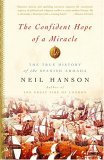
While I learned many things in the book, a few tidbits stood out. First, almost no ships were sunk via direct engagement. I had always envisioned the Spanish fleet going down in flames as English ships raked them cannon fire. In reality, the crews and crown preferred to capture enemy vessels as prizes, so there was less incentive to simply sink enemy vessels; also, given the ships were made of a floating material, it was just plain hard to sink a ship. Most of the Spanish ships were damaged heavily and the lost to storms, mostly after the engagements as they circled back around Ireland trying to return to Spain after running up the English Channel and failing to land. (They couldn't return via the English Channel because of the prevailing winds; as a fleet their ships could not sail closer than 90 degrees to the wind.)
Another surprise was how ill-prepared England was. Elizabeth was frugal, to say the least, and did not keep a standing navy, relying instead of privateers. Moreover, she was hesitant to spend enough to outfit the fleet, so that the fleet was starving, even in sight of England, and didn't have enough powder or shot to continue the fight. In fact the English really only had sufficient powder because they had a lucky capture of a Spanish ship loaded with powder. The Spanish Armada was really defeated with Spanish powder. Even after the victory, Elizabeth kept her purse strings tight and didn't pay the crews. The crews were turned out, wounded, in their battle stained clothes and typically no prize money, left to beg or otherwise find their way home.
Finally, it was interesting to see how completely outclassed the Spanish ships were. The English vessels were "race built", sleek and low to the water; by contrast, the Spanish ships were castles at sea. The English ships could sail closer to the wind and were much faster, giving them the freedom to dictate the terms of battle. Furthermore, the English cannons had much longer range and were set on wheeled carts so they could be retracted after firing and reloaded quickly; the Spanish cannons were fixed and had to be reloaded from outside the ship. As a result, the English could sustain a much higher rate of fire (something like 3-5x I think); no English ships were lost to Spanish fire.
Hanson's writing is excellent and engrossing. The book provides great insights into this well-known, but little understood event. I highly recommend it.
Sean Reply
And here I thought I would learn everything I needed to about the Spanish Armada by watching "Elizabeth: The Golden Age."